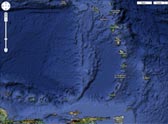Dominica

Intimate photos of the imperial parrot family
The Amazona Imperialis well deserves its name: the natural cavities in trees that Dominica’s imperial parrot family has claimed as nurseries are of truly palatial dimensions. For the first time, intimate photos shed light on what goes on in the nests of these feathered royals and their offspring.
By Bernhard Grdseloff
By Bernhard Grdseloff
"The young birds practice flying in the safety of the cavities," reveals Bertrand Baptiste. "They need the space to flap their wings."
With a team of scientists, the bird expert is studying the nesting behavior of the spectacular birds, found nowhere in the world but on Dominica, the "nature island". In order to observe the birds without disturbing them, the researchers place hidden cameras in and around the nesting cavities – no easy task.
"Only the towering giants deep in the jungle have cavities that are big enough," says Baptiste. "The entrance also needs to be well camouflaged with ferns and climbers to satisfy the females." Her imperial highness lays a single egg and tends her noble offspring until it can fly. The male never enters the nest; his job is to supply food, first for his queen, and then for the prince or princess as well.
The scientists hope their observations will help them find a way to keep the winged royals from extinction. "There are only 150, at most 200 of them left out there," estimates Baptiste.
With a team of scientists, the bird expert is studying the nesting behavior of the spectacular birds, found nowhere in the world but on Dominica, the "nature island". In order to observe the birds without disturbing them, the researchers place hidden cameras in and around the nesting cavities – no easy task.
"Only the towering giants deep in the jungle have cavities that are big enough," says Baptiste. "The entrance also needs to be well camouflaged with ferns and climbers to satisfy the females." Her imperial highness lays a single egg and tends her noble offspring until it can fly. The male never enters the nest; his job is to supply food, first for his queen, and then for the prince or princess as well.
The scientists hope their observations will help them find a way to keep the winged royals from extinction. "There are only 150, at most 200 of them left out there," estimates Baptiste.













